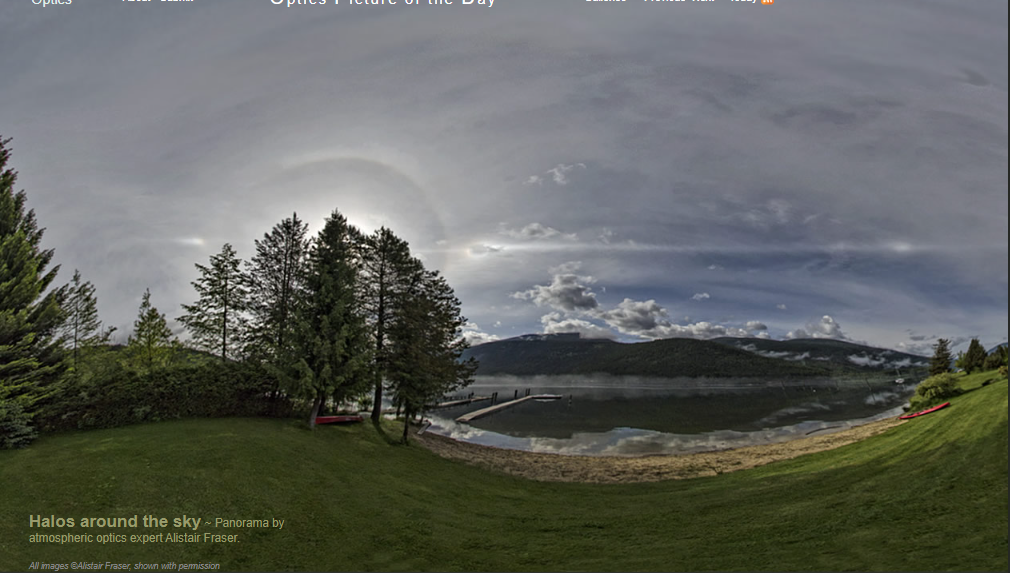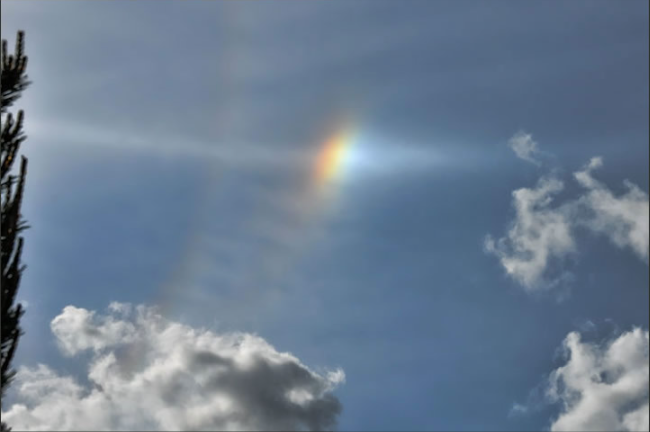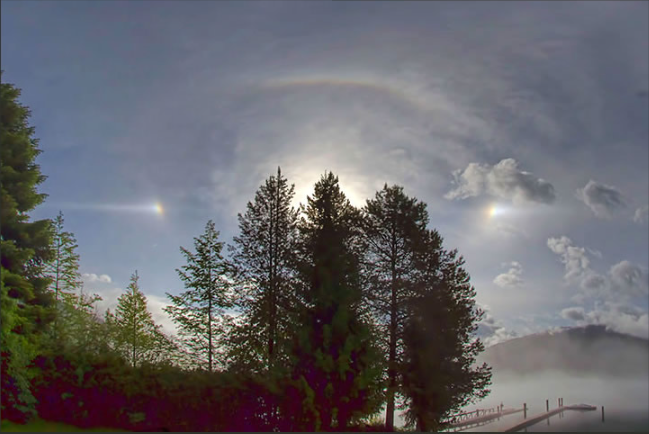Halos around the sky - OPOD
Halos around the Sky: A Fascinating Atmospheric Phenomenon
Halos around the sky are a captivating atmospheric optics phenomenon that occurs when sunlight interacts with ice crystals in the atmosphere. These stunning displays of light can create a range of optical effects, including parhelia (also known as sundogs), 22° halos, and paranthelions. While halos are relatively rare in certain regions, they can be observed in various parts of the world under specific weather conditions.
One such location where halos are not commonly seen is Kootenay Lake in British Columbia, Canada. Atmospheric optics expert Alistair Fraser recently captured an extraordinary panorama of halos around the sky at this location. The sighting included a particularly bright parhelion, which is the colored spot near the center of the image. The parhelion and the 22° halo, represented by the nearly vertical line on the left, are both products of sunlight refracting through hexagonal ice crystals.
The distinction between the parhelion and the 22° halo lies in the size and orientation of the ice crystals. While the halo results from smaller tumbling crystals, the parhelion is formed by larger horizontally oriented ones. These larger crystals resemble hexagonal dinner plates spread out on a table and, as the sun rises above the horizon, sunlight passing through them takes a skewed path. This shift causes the parhelion to appear outside the halo.
As cirrus clouds drifted across the sky, the scene continued to transform. In a wider-angle view captured shortly after the initial image, parhelia were visible on either side of the sun, along with fragments of the parhelic circle and a portion of an upper tangential arc above the sun. The departing fog over the lake added an additional layer of mystique to the spectacle.
In a nearly half-sky panorama, one can observe the full extent of this atmospheric phenomenon. The 22° halo, accompanied by its two parhelia, is situated on the left side of the image. The parhelic circle, which extends across a significant portion of the sky, is caused by a single reflection of sunlight off the vertical sides of the hexagonal ice crystals. The paranthelion, located near the right edge of the picture, is a diffuse bright spot that sits 120° from the sun, earning it the name "120° parhelion." The paranthelion's complex explanation involves sunlight entering the top of a crystal, internally reflecting off adjacent sides, and exiting through the bottom.
When parhelia are particularly vibrant, it presents an opportune time to search for a paranthelion. These optical phenomena offer a unique glimpse into the intricate workings of light and ice crystals in our atmosphere. Understanding their formation and characteristics contributes to our knowledge of atmospheric optics and enables us to appreciate the natural wonders that surround us.
In conclusion, halos around the sky are captivating optical displays that occur when sunlight interacts with ice crystals in the atmosphere. Alistair Fraser's remarkable panorama of halos around Kootenay Lake showcases various manifestations of this phenomenon, including parhelia, 22° halos, and paranthelions. By unraveling the science behind these atmospheric optics phenomena, we gain a deeper appreciation for the beauty and complexity of our natural world.

Halos around the sky ~ Panorama by atmospheric optics expert Alistair Fraser.
All images ©Alistair Fraser, shown with permission
Alistair Fraser describes the sighting:
"Haloes are not all that common around Kootenay Lake .B.C., Canada. � at least when it is compared with other places I have lived. Further, of all the many haloes that can be seen, the paranthelion is sufficiently uncommon that I cannot recall having seen one here before.
The first thing I noticed as the radiation fog was clearing .that. morning was an unusually bright parhelion (also called a sundog because it dogs the Sun). The parhelion is the coloured spot near the center of .the image at right.. The parhelion and the 22� halo (the nearly vertical line on the left) are both explained by the refraction of sunlight through plate-like hexagonal ice crystals. The difference is that the halo results from smaller tumbling crystals, while the parhelion is from larger horizontally oriented ones. These larger crystals will fall almost like (hexagonal) dinner plates spread out on a table. As the Sun rises above the horizon (here its elevation is 34�), sunlight passing through the horizontally oriented plates takes a skewed path. This shifts the parhelion outside the halo. Also seen in the picture is the parhelic circle�the white horizontal line.
The scene kept changing as cirrus drifted across the sky. .The. wider-angle view .lower right. was taken a short time after the first picture. It shows parhelia on either side of the Sun, a portion of an upper tangential arc above the Sun and bits and pieces of the parhelic circle. The departing fog can be seen over the Lake in the lower right.
Finally, .there is. a nearly half-sky panorama .at top.. The 22� halo and its two parhelia are on the left, the parhelic circle extends across much of the sky, and the paranthelion is near the right edge of the picture. As this diffuse bright spot sits 120� from the Sun, it is also known as the 120� parhelion. The parhelic circle is explained by a single reflection of sunlight off the vertical sides of the hexagonal ice crystals. The paranthelion has a slightly more complex explanation. Sunlight enters the top of the crystal, is internally reflected in succession off adjacent sides of the crystal and exits the crystal bottom. The adjacent vertical sides of the crystal form a corner reflector with an internal angle of 120� and this deviates the light by the observed 120�. When parhelia are particularly bright, it is a good time to look for a paranthelion."


Note: this article has been automatically converted from the old site and may not appear as intended. You can find the original article here.
Reference Atmospheric Optics
If you use any of the definitions, information, or data presented on Atmospheric Optics, please copy the link or reference below to properly credit us as the reference source. Thank you!
-
<a href="https://atoptics.co.uk/blog/halos-around-the-sky-opod/">Halos around the sky - OPOD</a>
-
"Halos around the sky - OPOD". Atmospheric Optics. Accessed on April 19, 2024. https://atoptics.co.uk/blog/halos-around-the-sky-opod/.
-
"Halos around the sky - OPOD". Atmospheric Optics, https://atoptics.co.uk/blog/halos-around-the-sky-opod/. Accessed 19 April, 2024
-
Halos around the sky - OPOD. Atmospheric Optics. Retrieved from https://atoptics.co.uk/blog/halos-around-the-sky-opod/.